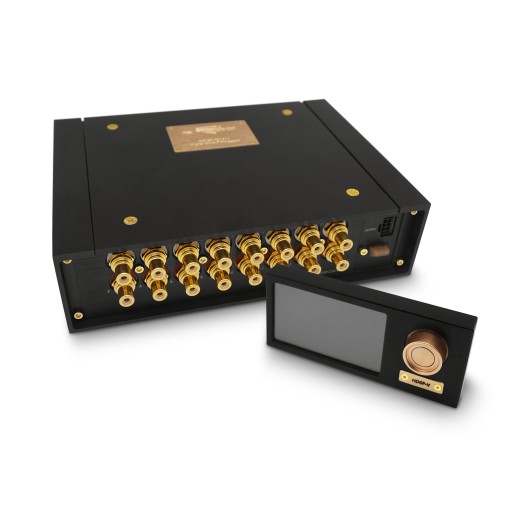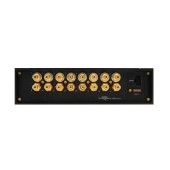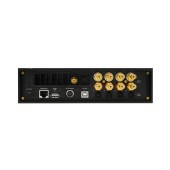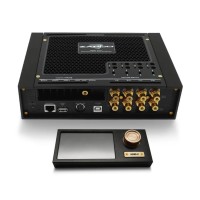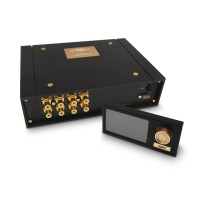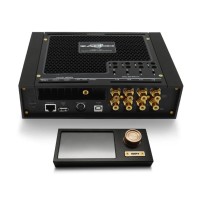DSP processor Zapco HDSP-Z16 V AD-16D - used goods
More about the product
- You can return the goods to us within 14 days
- DSP processor 100% functional.
- Original box slightly damaged.
- Controller shows visible signs of use.
DSP Processor Zapco HDSP-Z16 V AD-16D
It’s hard to say where science ends and passion begins when both work toward the same goal. That is how Zapco’s fifth-generation processors were born. Passion drives the project and the research was focused on creating a digital system that would deliver the sound of the best digital and analog systems available today. After all, listening to live music is an entirely analog experience. The aim is not only the cleanest possible sound reproduction, but the cleanest reproduction for the listening environment — whether that is in a car, a living room, or a concert hall. We brought together electronics, acoustics, and digital-processing experts to make that vision a reality. The V HDSP series introduces features and sound quality previously unseen in automotive DSP. With up to 16 channels you can build active systems in every corner of a multi-channel setup. HD means the DSP includes an HD player. Zapco HD processors actually exceed today’s standard 24-bit with high-resolution 96/192 kHz capability. That means you can reproduce music better than MP3 and even better than CD today. And when the next step in HD playback arrives, Zapco HDSP will be ready. Built-in Wi‑Fi and optional aptX HD Bluetooth allow the HDSP to connect to all auxiliary “smart” devices.
- 16-channel DSP processor with HD player
- Modular system: high-end solution with 15 independent PCBs
- Player performance: 456 MHz — ARM9 32-bit; playback up to 192 kHz/24-bit
- 8 analog RCA inputs
- 8 analog high-level inputs
- 5 digital inputs (S/PDIF and coax)
- 16 analog outputs
- DSP Processor: OMAP L-138 — 2 x 456 MHz, 32-bit (up to 64-bit / IEEE double precision)
- DSP sampling rate: 192 kHz
- Supported formats: WAV, AIF, AIFF, FLAC, ALAC, AAC, MP3
- USB support: FAT32 up to 2 TB
- ADC processor: AK5558, 32-bit, 784 kHz, 115 dB DNR
- DAC processor: AK4458, 32-bit, 784 kHz, 115 dB DNR
- Frequency range: 5 – 90,000 Hz
- THD+N: 0.0006 (digital input) or 0.0008 (analog input) @ 1 V out
- S/N device floor noise: -125 dB (20 Hz–20 kHz), -135 dB (150 Hz–20 kHz), -140 dB (80 Hz–20 kHz)
- S/N ratio (digital inputs): 115–120 dB A-weighted
- S/N ratio (analog inputs): 109–115 dB A-weighted
- Crosstalk: >110 dB (300 Hz–0.9 kHz)
- Crosstalk: average 115 dB (300 Hz–0.9 kHz)
- Input sensitivity (analog RCA inputs): 6/8 x RCA 1–5 V
- High-level input sensitivity: 4–20 V
- Digital inputs: optical 24-bit/192 kHz, S/PDIF 24-bit/192 kHz, 3 x i2S 24-bit/192 kHz
- Analog outputs: 8 x RCA, 4 V (5 kΩ), output impedance: 100 Ω
- 3" touchscreen controller included
- Controller can recall 10 preset positions
- Remote control of basic functions: Volume / Balance / Fader / Tone
- Remote playback control by File, Artist, Album, Title
- Wi‑Fi module for wireless setup included
- I/O setups: 2ch, 4ch, 6ch, 8ch, OEM SUM, AUX
- Digital input modes: HD, Optical, Coax, i2S 1, 2, 3
- Parametric EQ — 15 bands
- Detailed crossovers for each channel
- Phase filter: all channels, 1 Hz stepping and 1° increments
- VSEQ filter: 50–200 Hz, 1 Hz stepping
- Operating voltage: 6–16 V; quiescent current: 750 mA @ 14.4 V; fuse: 1 A
- Stop‑start system support
- Processor dimensions: 217 x 164 x 57 mm
- Controller dimensions: 111 x 16 x 49 mm
Unique PC Software
Of course, the software is what lets you extract the desired results from all that hardware, and important improvements have been made here as well. You can now control the DSP from a PC, as well as from a smartphone or tablet running iOS or Android. Despite the size limitations of mobile devices, you can fully configure your system using an intuitive mobile app. The best experience, however, is the graphical user interface for PC. Here are some of the new and unique features of the PC GUI — you’ll find we upgraded almost everything:
- Input options now include Bluetooth for streaming digital music.
- The input map lets you choose which input feeds each output. The system provides sensible defaults based on your input source, but you can override them as your system requires.
- Measure the distance from the listening position to each speaker and click Delay Calc. The system will compute all signal delays for you, with manual fine-tuning available if needed.
- Drop-down menus for each of the 8 output channels let you identify each driver by function. When assigned, the system applies default crossovers to protect your speakers.
- Link buttons let you group channels so you can set crossover, delay, and gain together. Select a channel and click another to link; click again to unlink.
- Filter types now include Linkwitz‑Riley, Butterworth, and Bessel, with slopes from 6 dB/octave to 48 dB/octave.
- The EQ link bar allows channels to be linked for equalization so you can adjust them together, un-link for fine-tuning a single channel, then re-link while preserving relative differences.
- The EQ bar displays everything you need while tuning: band type, frequency, gain, and Q. You can switch between GEQ and PEQ, temporarily bypass EQ, or reset a channel completely.
- When tuning 8 channels with 31 bands each it’s easy to lose focus, so you can shade parts of the graph and highlight only the frequencies for the channel you’re working on to concentrate on the available spectrum for that channel.
Mobile App
The Zapco apps for Android and iOS are identical and allow system setup via smartphone or tablet. The goal was to create a control system that’s clear on a smaller screen while still enabling the user to perform everything required for a complete setup and fine-tuning. When you open the ZIV II app, your device syncs with the settings in the active preset on your DSP, so the app always opens to what you are listening to. On the channel page you can assign each speaker’s function, select which input channel the speaker uses, check phase polarity, and adjust individual channel gains. When you assign speaker functions on the Channels tab, the system applies default crossovers to protect drivers from potentially damaging frequencies. You can customize the crossovers to suit your individual system. The Delay tab lets you enter centimeters or inches and immediately provides the corresponding delay in milliseconds for accurate playback. The EQ tab contains the heart and brain of the app: use either graphical or parametric EQ with up to 31 bands, adjusting gain, frequency, and Q. Work on channels individually or link them into pairs using the link icons. At the top of the page you can save and load DSP presets to or from a file on your phone or tablet. The graph shows how your adjustments affect the signal through the amplifier, and a drop-down lets you choose whether to display only the active channel or multiple channels on the graph.
About the Zapco Brand
Zapco is the oldest hi‑end car‑audio brand in the world, specializing in premium amplifiers and DSP processors for vehicles. Founded in the USA in 1974, the company has collected awards ever since — from prestigious organizations recognizing product quality and innovation to global sound‑quality competitions. Zapco amplifiers deliver uncompromising audiophile quality, define the standard of excellence, and set the benchmarks against which other products in the category are judged. For more than 45 years Zapco has relentlessly pursued new ways to bring better sound into the automotive environment, and that dedication to absolute sound quality continues to produce new technologies and high‑end products. Why? Because nothing else can move the soul and bring tears to the eyes like music. Music makes us move with joy, and of all the arts it has the most immediate and powerful effect on body and mind. Reproducing music in all its beauty and subtlety deserves nothing less than the fullest effort of everyone at Zapco. And because... music matters!
| Catalog number | HDSP-Z16 V AD-16D-P1 |
| Brand | Zapco |
| Links | Official web presentation (English) |
